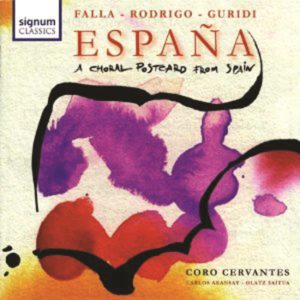Debra Shearer-Dirié
España: A Choral Postcard from Spain (Signum)
This extensive selection of choral music from Spain is an essential for all choral enthusiasts. Its twenty-five tracks take a narrative journey through the towns of Aranjuez, La Mancha, Extremadura, Valladolid, Salamanca, Galicia, Asturias, Cantabria, before finally arriving in Valencia and Alicante. The CD notes accompanying this recording read like a storybook, dipping into historical facts, and presenting sociological and geographical influences that have shaped the musical history of Spain. With such breadth of information, Carlos Aransay, Director of Coro Cervantes, and Rupert Damerell, have provided the context for the listener to hear this music of the ‘folk’ with informed ears.
Well known for its dedication to the classical music of the Iberian Peninsula and Latin America, Coro Cervantes captures the character and nature of these pieces with much flair. Since the ensemble was founded in 1995 by Aransay, its repertoire has spanned the Middle Ages to the 21st Century. Their list of performances boast the finest cathedrals and concert halls across England, Europe, and Central and South America.
The CD notes state that Spain “has always been a melting pot of different cultures, languages, religions, and traditions.” Aurtxoa Sehaskan (track 3) from the Basque region, is a lullaby sensitively set by Gabriel de Olaizola and arranged by his brother José. Olatz Saitua, the soprano soloist for this piece, carries the listener through this lullaby with ease and beauty. Arrorró (track 19), a lullaby from Las Palmas, the capital of the Canary Islands, is the region’s official anthem, beautifully arranged by Juan José Falcon Sanabria.
The flexibility and agility of the voices in El Vito (track 4) perfectly denotes the strong rhythmic pulse of the accompaniment, originally for guitar. This fiery dance would have been performed in the taverns of Andalucía by the women imitating the movements of the bullfighter. The persisting rhythmic nature of Xivarri (track 2) evokes the ‘mascletás’, the deafening displays of firecrackers and rockets typical of the Valencia region. Volar (track 6) comes from the region of Cantabria, the contrast of its landscape, set between its seafaring heritage and its mountainous areas. The calling ‘Volar’ echoes through the mountains as it is passed from voice to voice. Ton pare no té nas (track 10) is a perfect midpoint for this recording, with its light nature, a nursery-rhyme all about noses!
The ‘villancico’ is a prominent form; it was developed in the 15th century in the Iberian Peninsula and used in popular religious music with vernacular texts. The texts vary and it is perhaps those for Christmas that are better known. Some elements of the ‘villancico’ are evident in El gavilán (The sparrow hawk, track 18). In Adiós Granada (track 21), sung by Tordiyo in the zarzuela Los Emigrantes, Saitua once again captures the flamenco style in the lavishly decorative melodic line, whilst accompanied by the percussive rasgueo, perhaps reminiscent of the flameno dancer’s feet and the castanets.
The compilation concludes with Manuel de Falla’s Balada de Mallorca with its soothing, lilting waves of sound. The singers of Coro Cervantes capture every nuance in this music from Spain. The narratives of these pieces need to be told in a way that captures every twist in the storyline, celebrates every joy, paints the picture of the most beautiful landscape, or gently lulls the young child to sleep. Aransay leads his singers through every one of these emotions with careful attention and devotion in a collection of music that is close to his heart.



